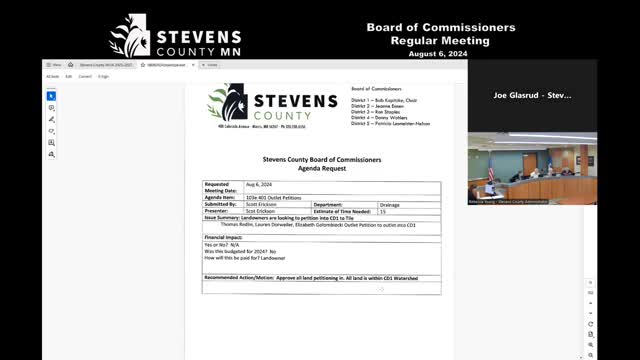Residents petition for drainage solutions amid flooding crisis
August 07, 2024 | Stevens County, Minnesota
This article was created by AI summarizing key points discussed. AI makes mistakes, so for full details and context, please refer to the video of the full meeting. Please report any errors so we can fix them. Report an error »

In a recent Stevens County Board of Commissioners meeting, three petitions were presented seeking drainage outlets into the Stevens County ditch, highlighting ongoing concerns about water management in the area. The petitions were submitted by Elizabeth Glombecki, Lauren Dorweiler, and Beakstone Colony, each requesting outlets for specific parcels of land within the watershed of County Drainage District One.
Glombecki's petition pertains to a 40-acre parcel in Section 23, while Dorweiler's request involves 120 acres in the same section. Beakstone Colony is seeking an outlet for a portion of land in Section 35. The board discussed the historical context of these petitions, noting that some of the land had previously been included in the benefited areas but was later removed due to perceived insufficient benefits.
Scott, a representative involved in the drainage authority discussions, presented maps illustrating the watershed and the affected parcels. He explained that the petitions were necessary to facilitate drainage for landowners who are currently dealing with wet conditions that hinder agricultural productivity. The board acknowledged the importance of these outlets, as they would allow for better water management and improved land usability.
Public comments during the meeting raised concerns about the potential impacts of increased drainage on neighboring properties. Local farmers expressed worries about how the proposed drainage systems might affect water flow and exacerbate flooding issues in the area. One farmer, Brian Wills, emphasized the need for careful management to ensure that water is directed appropriately and does not create additional problems for adjacent landowners.
The board is expected to review the petitions further and consider the implications of granting these drainage outlets, balancing the needs of individual landowners with the broader community's water management challenges. The discussions reflect ongoing efforts to address agricultural drainage issues while maintaining equitable water flow across the region.
Glombecki's petition pertains to a 40-acre parcel in Section 23, while Dorweiler's request involves 120 acres in the same section. Beakstone Colony is seeking an outlet for a portion of land in Section 35. The board discussed the historical context of these petitions, noting that some of the land had previously been included in the benefited areas but was later removed due to perceived insufficient benefits.
Scott, a representative involved in the drainage authority discussions, presented maps illustrating the watershed and the affected parcels. He explained that the petitions were necessary to facilitate drainage for landowners who are currently dealing with wet conditions that hinder agricultural productivity. The board acknowledged the importance of these outlets, as they would allow for better water management and improved land usability.
Public comments during the meeting raised concerns about the potential impacts of increased drainage on neighboring properties. Local farmers expressed worries about how the proposed drainage systems might affect water flow and exacerbate flooding issues in the area. One farmer, Brian Wills, emphasized the need for careful management to ensure that water is directed appropriately and does not create additional problems for adjacent landowners.
The board is expected to review the petitions further and consider the implications of granting these drainage outlets, balancing the needs of individual landowners with the broader community's water management challenges. The discussions reflect ongoing efforts to address agricultural drainage issues while maintaining equitable water flow across the region.
View full meeting
This article is based on a recent meeting—watch the full video and explore the complete transcript for deeper insights into the discussion.
View full meeting
